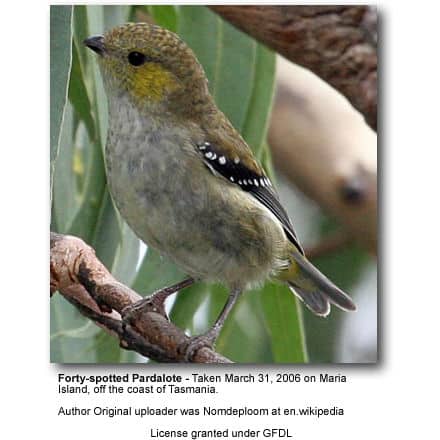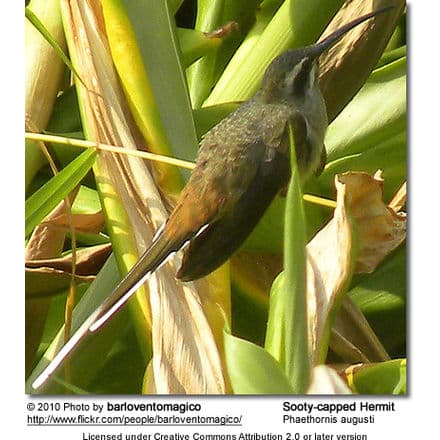Australian Warblers
The Australian Warblers large and diverse passerine bird family Pardalotidae includes the pardalotes, scrubwrens, thornbills, gerygones, and allies. The family originated in Australasia and now includes about 70 species in 15 or 16 genera.
Nearly all are confined to Australia (48 species) or New Guinea (about 20 species, including 6 found in both Australia and New Guinea).
Only the gerygones extend further afield, with representatives in Southeast Asia, New Zealand, and islands of the South Pacific.

All members are small to medium in size—some are very small—the majority are drab, inconspicuous, and often difficult to identify. All are mainly insectivorous, and have 10 primaries (the tenth is vestigial in the pardalotes) and 9 secondaries (shorter, upper “arm” feathers) (most having a vestigal tenth secondary).
One species, the Lord Howe Gerygone Gerygone insularis, is extinct; and 25 taxa in 17 species are considered endangered, three of them critically so. The primary threats are land clearing, overgrazing, degradation and fragmentation of habitat, and changing fire regimes.
The taxonomy of the Pardalotidae is complex and its classification has changed a great deal over the years. Recent microbiological work has made it clear that it is part of the Australasian corvid lineage, and it is most closely related to the honeyeaters and the fairy-wrens, all three families being regarded as part of the superfamily Meliphagoidea. (The Pardalotidae form the second-largest family of birds in Australasia, after the honeyeaters.)
At various times the Pardalotidae have been classified as Old World warblers, Old World babblers, and Old World flycatchers. The pardalotes themselves have been placed alone in their own family and grouped with the flowerpeckers. DNA studies suggest that the pardalotes may diverge sufficiently from the others in the group to justify regarding them as a separate family, in which case the remaining genera would be placed in the family Acanthizidae.
Species of Pardalotidae (part of Meliphagoidea – a superfamily of passerine birds)
- Subfamily Pardalotinae: pardalotes
- Spotted Pardalote, Pardalotus punctatus
- Forty-spotted Pardalote, Pardalotus quadragintus
- Red-browed Pardalote, Pardalotus rubricatus
- Striated Pardalote, Pardalotus striatus
- Eastern Bristlebird, Dasyornis brachypterus
- Rufous Bristlebird, Dasyornis broadbenti
- Western Bristlebird, Dasyornis longirostris
- Pilotbird, Pcynoptilus floccosus
- Rockwarbler, Origma solitaria
- Fernwren, Oreoscopus gutturalis
- Yellow-throated Scrubwren, Sericornis citreogularis
- White-browed Scrubwren, Sericornis frontalis
- Tasmanian Scrubwren, Sericornis humilis
- Atherton Scrubwren, Sericornis keri
- Large-billed Scrubwren, Sericornis magnirostris
- Tropical Scrubwren, Sericornis beccarii
- Scrubtit, Acanthornis magnus
- Chestnut-rumped Heathwren, Hylacola pyrrhopygia
- Shy Heathwren or Shy Hylacola, Hylacola cauta
- Striated Fieldwren, Calamanthus fuliginosus
- Rufous Fieldwren, Calamanthus campestris
- Redthroat, Pyrrholaemus brunneus
- Speckled Warbler, Chthonicola sagittata
- Weebill, Smicrornis brevirostris
- Brown Gerygone, Gerygone mouki
- Grey Warbler, Gerygone igata
- Chatham Island Warbler, Gerygone albofrontata
- Norfolk Island Gerygone, Gerygone modesta
- Dusky Gerygone, Gerygone tenebrosa
- Mangrove Gerygone, Gerygone levigaster
- Western Gerygone, Gerygone fusca
- Lord Howe Gerygone, Gerygone insularis Conservation status: Extinct (c.1930)
- Large-billed Gerygone, Gerygone magnirostris
- Green-backed Gerygone, Gerygone chloronotus
- Fairy Gerygone, Gerygone palpebrosa
- White-throated Gerygone, Gerygone olivacea
- Mountain Thornbill, Acanthiza katherina
- Brown Thornbill, Acanthiza pusilla : The Brown Thornbill is a passerine bird usually found in eastern and south-eastern Australia, including Tasmania. It can grow up to 10 cm long and feeds on insects.
- Inland Thornbill, Acanthiza apicalis
- Tasmanian Thornbill, Acanthiza ewingii
- Chestnut-rumped Thornbill, Acanthiza uropygialis
- Slaty-backed Thornbill, Acanthiza robustirostris
- Western Thornbill, Acanthiza inornata
- Buff-rumped Thornbill, Acanthiza reguloides
- Slender-billed Thornbill, Acanthiza iredalei
- Yellow-rumped Thornbill, Acanthiza chrysorrhoa : The Yellow-rumped Thornbill or Australian Sylviae is a species of passerine bird from the Acanthiza genus.
- Yellow Thornbill, Acanthiza nana : The Yellow-rumped Thornbill or Australian Sylviae is a species of passerine bird from the Acanthiza genus.
- Striated Thornbill, Acanthiza lineata
- Southern Whiteface, Aphelocephala leucopsis
- Chestnut-breasted Whiteface, Aphelocephala pectoralis
- Banded Whiteface, Aphelocephala nigricincta




